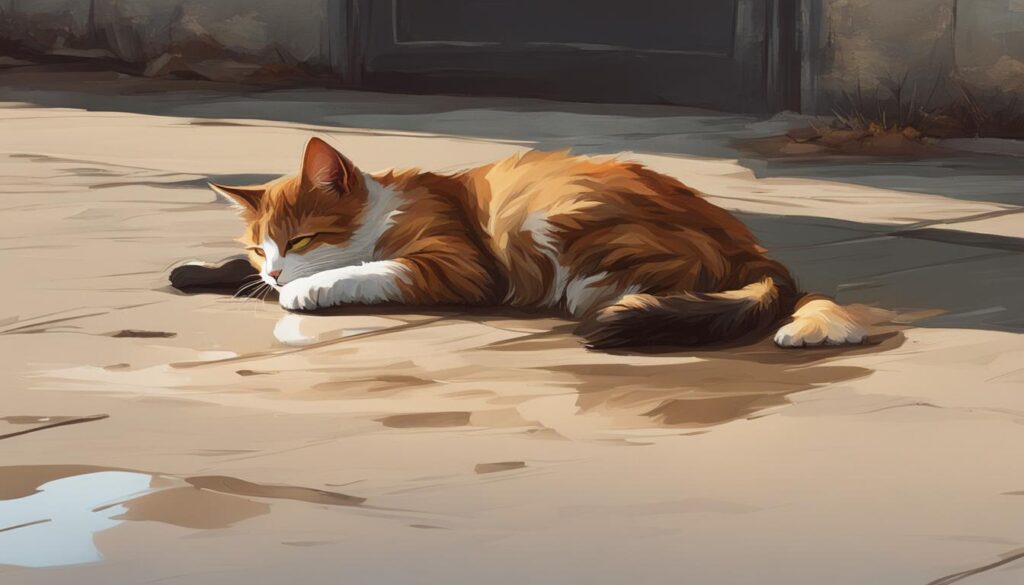Can Cats Get Parvo? Feline Parvovirus Facts
Feline panleukopenia (FP), also known as feline parvovirus, is a highly contagious viral disease that affects cats. While cats of any age may be infected, young kittens, sick cats, and unvaccinated cats are most susceptible. The feline parvovirus is widespread in the environment and can be transmitted through urine, stool, nasal secretions, and fleas.
Feline parvovirus can cause severe symptoms such as fever, diarrhea, vomiting, and dehydration. In young kittens, the virus can also lead to damage to the brain and eyes. Prompt and intensive care is crucial for the survival of infected cats.
To learn more about feline parvovirus and its impact on cats, read on for key facts and information.
Key Takeaways:
- Feline parvovirus, also known as feline panleukopenia, is a highly contagious viral disease of cats.
- Youth kittens, sick cats, and unvaccinated cats are most susceptible to feline parvovirus.
- The virus can be transmitted through urine, stool, nasal secretions, and fleas.
- Feline parvovirus can cause severe symptoms including fever, diarrhea, vomiting, and dehydration.
- Proper care and vaccination are essential for preventing and treating feline parvovirus.
Symptoms of Parvo in Cats
When cats are infected with the feline parvovirus, they may exhibit various symptoms that indicate the presence of the disease. Recognizing these symptoms is crucial for prompt diagnosis and treatment. Common symptoms of parvo in cats include:
- Depression: Infected cats often appear lethargic, withdrawn, and exhibit a general lack of interest in their surroundings.
- Loss of Appetite: Cats with parvo may experience a decreased appetite or refuse to eat altogether.
- High Fever: A significantly elevated body temperature is a typical sign of parvovirus infection.
- Lethargy: Cats infected with parvo often become weak and lack energy.
- Severe Diarrhea: Infected cats may experience frequent and watery diarrhea, which can lead to dehydration.
- Nasal Discharge: Some cats with parvovirus infection may have a runny nose or sneezing.
- Dehydration: Severe diarrhea and vomiting can lead to dehydration, which requires urgent medical attention.
In addition to these symptoms, young kittens infected with the feline parvovirus may also exhibit tremors and severe movement difficulties. These neurological symptoms result from the virus’s damage to the cerebellum, the part of the brain responsible for motor coordination.
It is essential to note that the symptoms of parvo in cats can resemble those of other illnesses and diseases, making diagnosis challenging. Consulting a veterinarian is key to determining the accurate cause of the cat’s symptoms.
“Recognizing the symptoms of parvo in cats is crucial for prompt diagnosis and treatment.”
Diagnosing feline parvovirus involves conducting blood tests that show reduced levels of specific white blood cell types and identifying the presence of the virus in the cat’s stool. Confirmation of the diagnosis enables the veterinarian to provide appropriate treatment and care.

| Symptom | Description |
|---|---|
| Depression | Lethargy, withdrawal, lack of interest in surroundings |
| Loss of Appetite | Decreased or refusal to eat |
| High Fever | Significantly elevated body temperature |
| Lethargy | Weakened, lack of energy |
| Severe Diarrhea | Frequent, watery diarrhea leading to dehydration |
| Nasal Discharge | Runny nose, sneezing |
| Dehydration | Resulting from severe diarrhea and vomiting |
Treating Feline Parvovirus
When it comes to feline parvovirus, there isn’t a specific medication that can directly kill the virus. However, the focus of treatment is on providing supportive care to help the cat recover. This involves a combination of interventions aimed at managing the symptoms and supporting the cat’s overall health.
One of the primary goals of treatment is to address dehydration, as cats infected with parvovirus often experience severe diarrhea and vomiting, leading to fluid loss. To combat this, fluids and nutrients are administered intravenously to ensure proper hydration and nourishment.
Additionally, antibiotics may be prescribed to prevent and treat secondary bacterial infections that can arise due to the weakened immune system as a result of the virus.
It’s important to note that the prognosis for kittens under eight weeks old is generally poor. However, older cats have a better chance of survival with early intervention and intensive care.
To prevent the spread of the virus, infected cats should be isolated from other cats until they have fully recovered. It’s also crucial to maintain good hygiene practices, such as regularly cleaning litter boxes and disinfecting any contaminated surfaces.

It’s important to be aware that even after recovering from feline parvovirus, cats may continue to shed the virus in their stool and urine for up to six weeks. Therefore, proper sanitation and hygiene measures should be consistently followed to prevent transmission.
Preventing Feline Parvovirus
Vaccination is the most effective method for preventing feline parvovirus infection in cats. By ensuring your cat receives the proper vaccines, you can significantly reduce the risk of them contracting this highly contagious disease.
Most kittens should receive their first vaccine between 6 and 8 weeks of age. This initial vaccine is usually followed by a series of booster shots until the kitten reaches around 16 weeks of age. The specific vaccination schedule may vary based on the health and risk factors of the individual cat.
Consulting with a veterinarian is crucial for determining the appropriate vaccination schedule for your cat.
In addition to vaccination, there are other preventive measures you can take to minimize the chances of feline parvovirus transmission:
- Isolate infected cats: If you have a cat that has been diagnosed with parvovirus, keep them separate from other cats to prevent spreading the virus.
- Practice proper hygiene: Wash your hands thoroughly after handling any potentially contaminated materials and avoid direct contact with infected cats.
- Disinfect contaminated materials: Clean and disinfect any objects or surfaces that may have been in contact with infected cats, such as litter boxes, bedding, and food bowls.
By following these preventive measures, you can create a safer environment for your cats and reduce the risk of feline parvovirus infection.
Remember, prevention is always better than treatment when it comes to feline parvovirus. Protect your furry friends by ensuring they receive the necessary vaccinations and taking appropriate preventive measures.
Transmission and Susceptibility of Feline Parvovirus
The feline parvovirus, also known as feline panleukopenia or feline distemper, is highly contagious and can be transmitted through various means. Infected cats can shed the virus through their secretions, such as urine, stool, and nasal discharge. Fleas can also act as carriers of the virus, transmitting it to other cats through bites. Additionally, the virus can survive on contaminated objects such as food bowls, bedding, and toys, further facilitating its spread.
While cats of any age can be infected with the feline parvovirus, certain groups are more susceptible to the disease. Young kittens, whose immune systems are still developing, are particularly vulnerable. Sick cats with weakened immune systems and unvaccinated cats also have a higher risk of contracting the virus.
The feline parvovirus is widespread throughout the United States and can be found in various environments where cats are housed together. Places like kennels, pet shops, and animal shelters are breeding grounds for the virus, as close proximity increases the chances of transmission.
Diagnosing feline parvovirus in cats involves considering the cat’s history of exposure to the virus, the absence of vaccination, and conducting specific laboratory tests. These tests assess the levels of different types of white blood cells, as well as the presence of the virus in the cat’s stool.
Preventing Transmission and Diagnosing Feline Parvovirus
To prevent the transmission of feline parvovirus, it is essential to practice good hygiene and take preventive measures. These include:
- Isolating infected cats to prevent contact with other cats.
- Regularly cleaning and disinfecting litter boxes, food bowls, and other cat accessories.
- Ensuring proper flea control to minimize the risk of transmission through fleas.
- Following a vaccination schedule recommended by a veterinarian, as vaccination is the best way to prevent feline parvovirus infection.
If a cat shows symptoms of the virus, seeking veterinary care is crucial. A veterinarian will take into account the cat’s clinical signs, conduct the necessary diagnostic tests, and provide appropriate treatment based on the severity of the infection.
Early diagnosis, prompt treatment, and preventive measures are essential in mitigating the impact of feline parvovirus and protecting the overall feline population.
| Transmission of Feline Parvovirus | Susceptibility |
|---|---|
| Infected cats’ secretions (urine, stool, nasal discharge) | Young kittens |
| Fleas | Sick cats |
| Contaminated objects | Unvaccinated cats |
Conclusion
Feline parvovirus, also known as feline panleukopenia or feline distemper, is a highly contagious viral disease of cats. It primarily affects kittens, sick cats, and unvaccinated cats. The virus attacks rapidly growing cells in the body, causing severe symptoms such as fever, diarrhea, vomiting, and dehydration. Prompt treatment and supportive care are necessary for the survival of infected cats.
Vaccination is crucial for preventing feline parvovirus infection. It is recommended to follow the appropriate vaccination schedule provided by a veterinarian. Regular check-ups and vaccinations are essential for protecting cats from this potentially deadly disease.
In addition to vaccination, practicing proper hygiene and isolation protocols can help reduce the transmission of feline parvovirus. Isolating infected cats, disinfecting contaminated objects, and maintaining a clean living environment are important preventive measures. Regular veterinary check-ups and prompt diagnosis of feline parvovirus can significantly improve the prognosis for infected cats.
In conclusion, feline parvovirus is a serious threat to cats, especially kittens, sick cats, and those who are unvaccinated. With proper veterinary care, vaccinations, and preventive measures, the impact of this highly contagious virus can be minimized. By staying informed and taking the necessary precautions, cat owners can help protect their beloved pets from the devastating effects of feline parvovirus.
FAQ
Can cats get parvo? What is feline parvovirus?
Yes, cats can get parvo. Feline parvovirus, also known as feline panleukopenia or feline distemper, is a highly contagious viral disease that primarily affects kittens, sick cats, and unvaccinated cats. It attacks rapidly growing cells in the body and can cause severe symptoms.
What are the symptoms of parvo in cats?
Symptoms of parvo in cats may include depression, loss of appetite, high fever, lethargy, severe diarrhea, nasal discharge, and dehydration. In young kittens, the virus can also cause tremors and severe movement difficulties due to damage to the cerebellum.
How is feline parvovirus treated?
There is no specific medication to kill the feline parvovirus, so treatment focuses on supportive care. This includes providing fluids and nutrients intravenously, correcting dehydration, and preventing secondary bacterial infections with antibiotics. Prompt and intensive care is crucial for the survival of infected cats.
How can feline parvovirus be prevented?
The best way to prevent feline parvovirus is through vaccination. Most kittens should receive their first vaccine between 6 and 8 weeks of age, with follow-up vaccines given until around 16 weeks of age. Adult vaccination schedules vary based on health and risk factors. Additionally, isolating infected cats, practicing proper hygiene, and disinfecting contaminated materials can help prevent the spread of the virus.
How is feline parvovirus transmitted, and which cats are most susceptible?
Feline parvovirus can be transmitted through infected cats’ secretions, fleas, and contaminated objects. Cats of any age can be infected, but young kittens, sick cats, and unvaccinated cats are most susceptible. The virus is widespread in all parts of the United States and is commonly found in places where cats are housed together, such as kennels, pet shops, and animal shelters.
How is the diagnosis of feline parvovirus made?
Diagnosis of feline parvovirus is based on a history of exposure, lack of vaccination, and laboratory tests that show reduced levels of white blood cell types and the presence of the virus in the cat’s stool.


